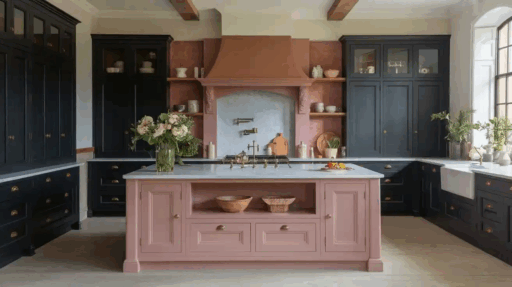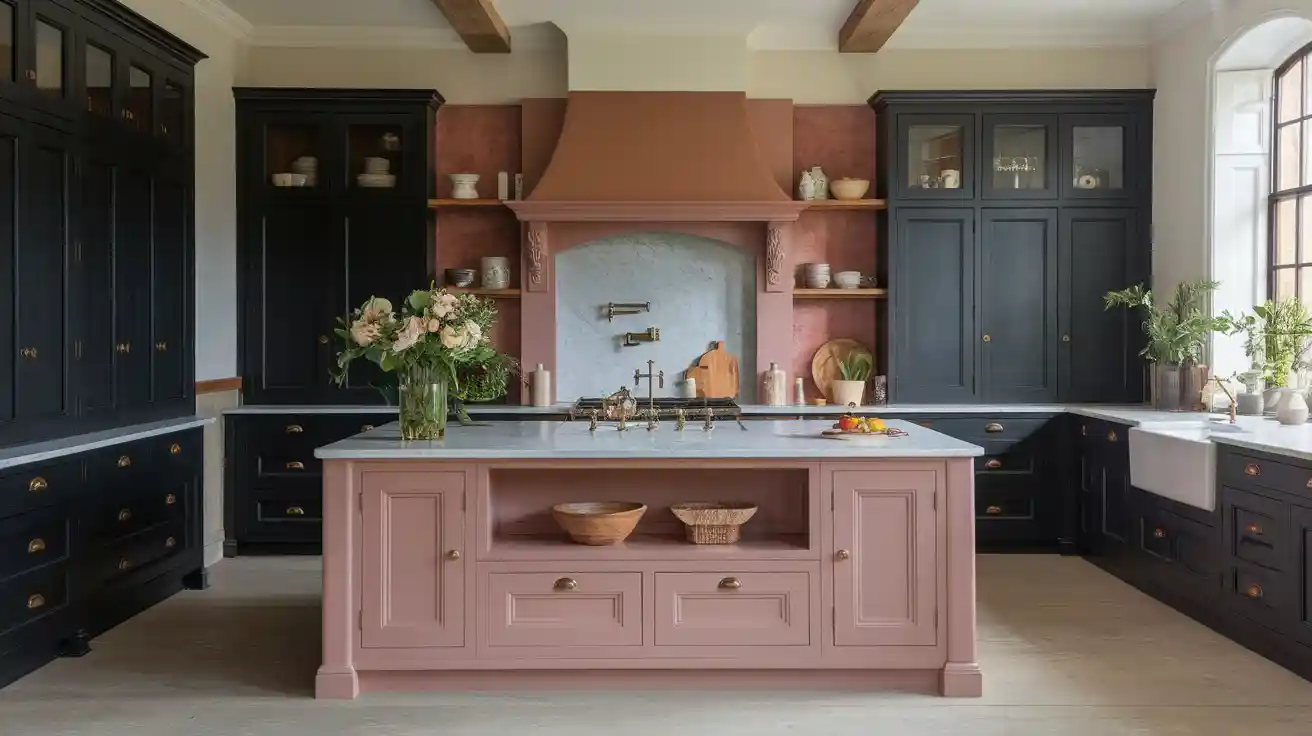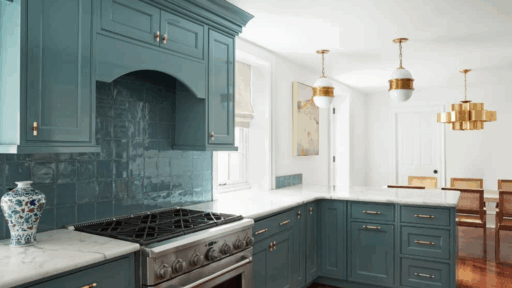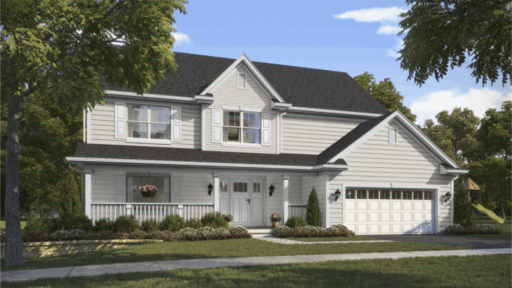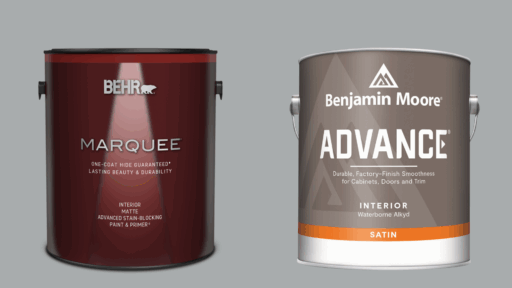When I chose dark cabinets for my kitchen, picking the right island color felt like the biggest design decision, and honestly, it turned out to be the most exciting part of the process.
A kitchen island doesn’t just fill space; it can ground the entire room or add contrast that completely shifts the mood.
From clean whites to warm wood and rich greens, the right island color brings balance, style, and a personal touch to your space.
In this blog, I’ll walk you through color pairings that work beautifully with dark cabinets. If you’re going for bold contrast or subtle coordination, this guide is here to help you decide with confidence.
Ready to see what works best for your kitchen? Let’s get into it!
Why Contrast Matters in Kitchen Design
When working with dark cabinets, such as deep espresso, midnight blue, or matte black, it’s essential to consider how to balance that richness with lighter or warmer tones.
Without contrast, your kitchen can feel heavy or overly monochromatic, especially if the lighting is limited. This is where a well-chosen island color makes a big difference.
A contrasting island acts as a visual break, helping to ground the kitchen layout while adding interest and depth. Lighter island colors like soft white, warm taupe, or pale gray can open up the space and keep the room from feeling too closed in.
Natural wood tones add warmth and a hint of organic texture, softening the overall look. The contrast also enhances spatial flow in open-concept kitchens.
An island in a brighter or unexpected color creates a central focal point, clearly defining work zones without using walls. It invites interaction, adds personality, and keeps the room from feeling flat.
Ultimately, contrast isn’t about clashing. It’s about creating harmony through difference. Allow your cabinets and island to complement each other, letting each element shine.
Top Kitchen Island Colors for Dark Cabinets
Learn which island colors best complement dark kitchen cabinets. These combinations enhance your kitchen’s design by adding warmth, contrast, or continuity depending on your desired style and atmosphere.
1. White

A white island introduces brightness and contrast into a kitchen with dark cabinets. It helps open up the space visually, especially in rooms with limited natural light.
White pairs well with almost any countertop or hardware finish and works in modern, classic, or farmhouse styles.
Its timeless appeal and fresh feel make it a versatile choice that keeps the overall kitchen design from feeling too heavy or dark.
2. Light Gray
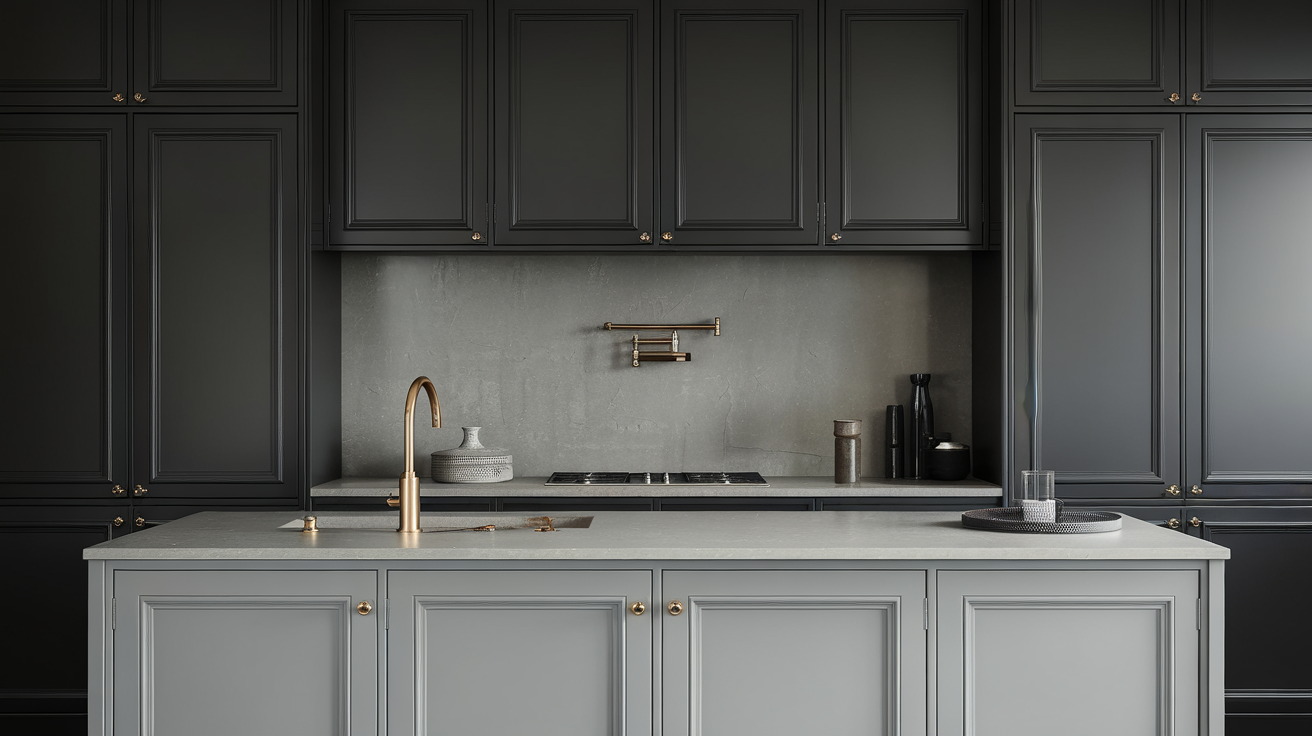
Light gray offers a soft, elegant contrast to dark cabinets without feeling stark. This neutral tone adds sophistication while allowing other design features to shine.
It complements silver, matte black, or brass fixtures and works with a wide range of countertop materials.
Ideal for minimalist, transitional, or contemporary kitchens, light gray maintains visual balance and a sense of calm while still adding subtle contrast and dimension.
3. Cream
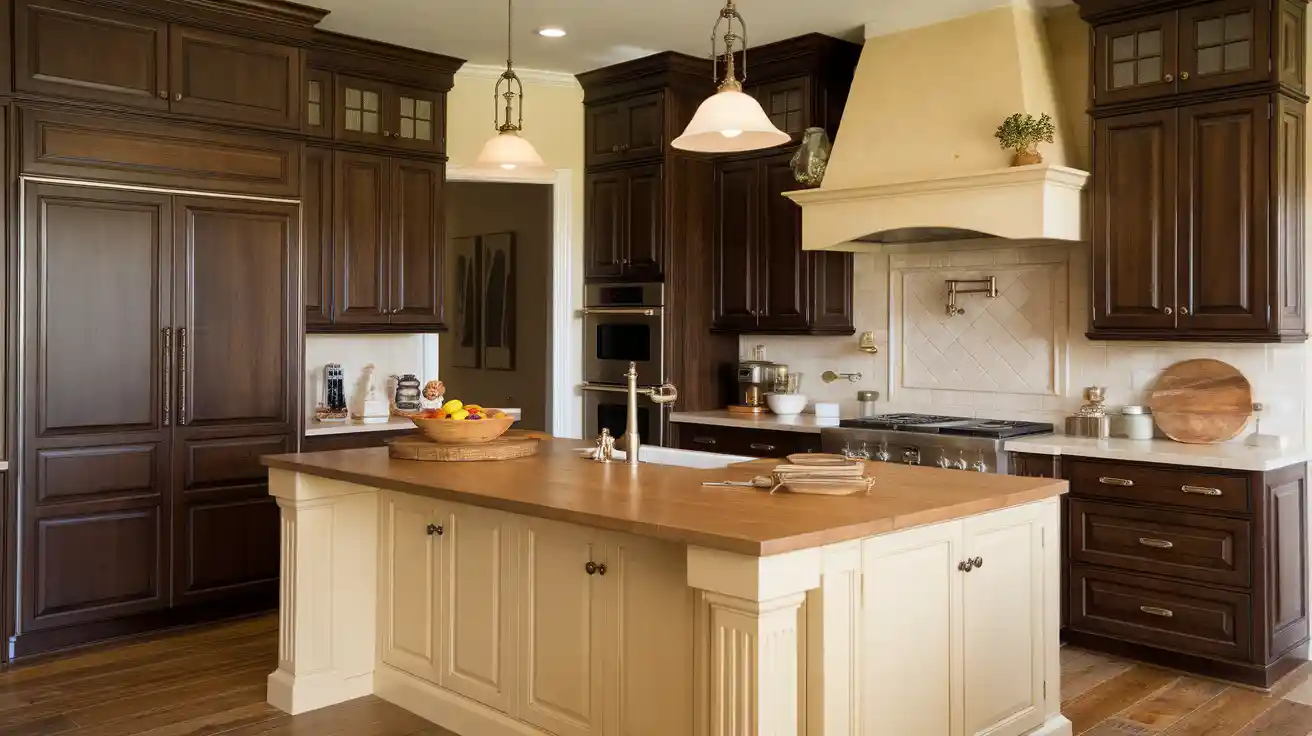
Cream brings a warm, inviting touch to kitchens with dark cabinetry. This soft, buttery tone contrasts just enough to define the island while keeping the palette cohesive.
Cream works beautifully in traditional or vintage-style kitchens and pairs well with natural materials like stone and wood.
It enhances cozy atmospheres and softens bolder cabinet colors without clashing, making it a great choice for a welcoming and balanced kitchen design.
4. Beige
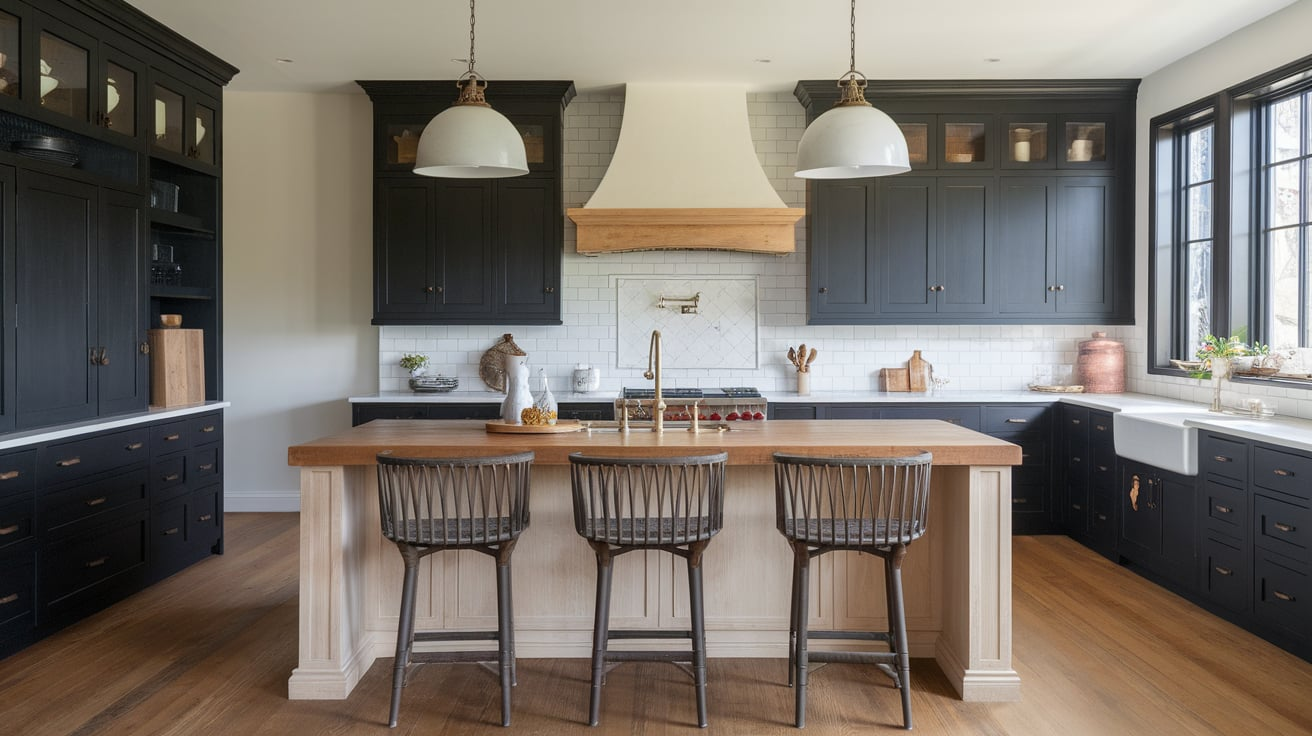
Beige islands offer a natural, grounded look that complements dark cabinets with warmth and subtle contrast.
This versatile neutral color supports a wide range of design styles, from Mediterranean to modern farmhouse. Beige works particularly well with wood floors, stone countertops, and warm metallic accents.
Its earthy tone adds depth without drawing too much attention, making it ideal for understated elegance and a harmonious kitchen palette.
5. Natural Wood Finish

A natural wood finish brings texture, warmth, and a touch of nature into dark-cabinet kitchens.
Whether it’s light oak, walnut, or hickory, wood provides an organic contrast that feels both timeless and cozy. It’s a flexible option that suits Scandinavian, rustic, or transitional designs.
Natural grain adds visual interest without bold color and pairs easily with stone counters and matte or brushed hardware for a balanced, inviting space.
6. Sage Green
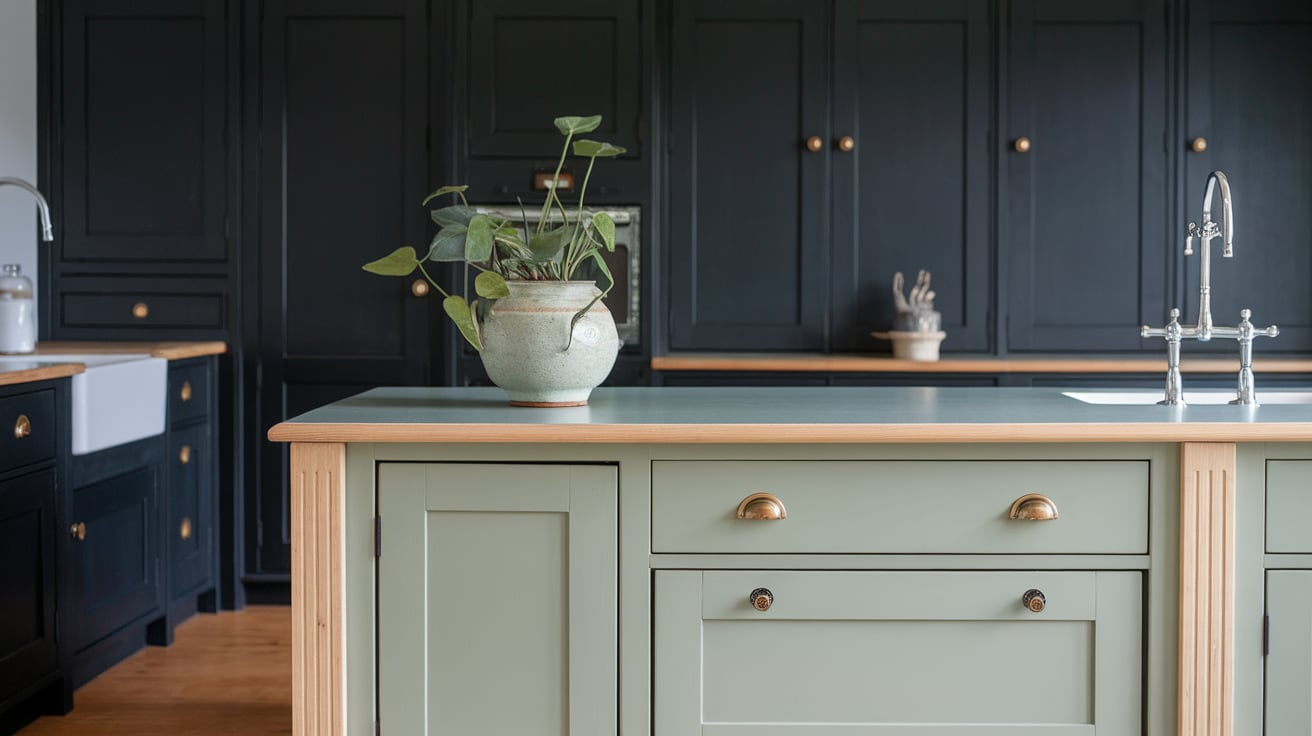
Sage green introduces a soothing, earthy tone that softens the depth of dark cabinets. This muted green feels calm and organic, perfect for nature-inspired kitchens.
It works well with white countertops, wood accents, and brass or black fixtures. Sage green is versatile, offering a subtle color that’s not overpowering.
It’s ideal for cottage, bohemian, or modern farmhouse kitchens and adds a relaxed, refreshing vibe to any layout.
7. Navy Blue
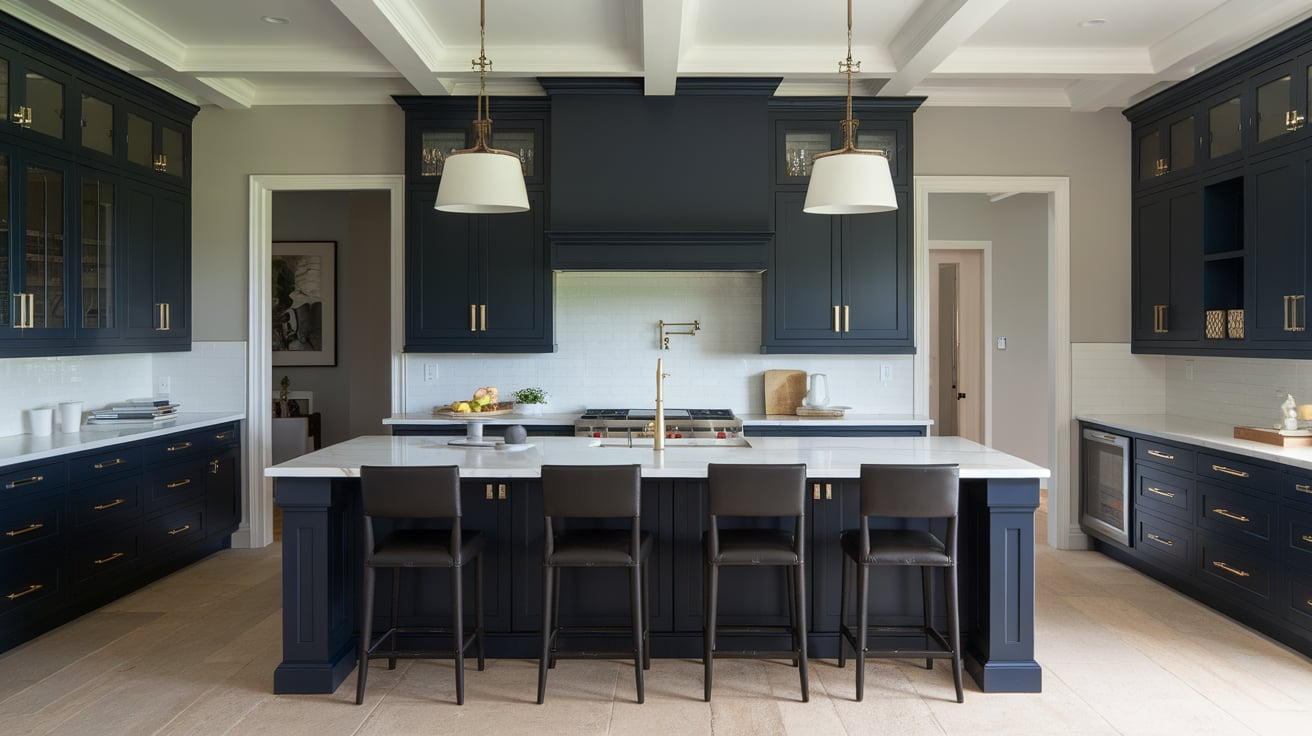
Navy blue islands offer a rich, saturated hue that pairs beautifully with dark cabinets.
This deep shade provides depth while maintaining visual harmony, especially when paired with white countertops or light backsplashes. Navy fits traditional, coastal, and contemporary kitchens alike.
It feels timeless and bold without being overwhelming and creates a polished, upscale aesthetic that draws the eye without clashing with darker surrounding elements.
8. Charcoal Gray
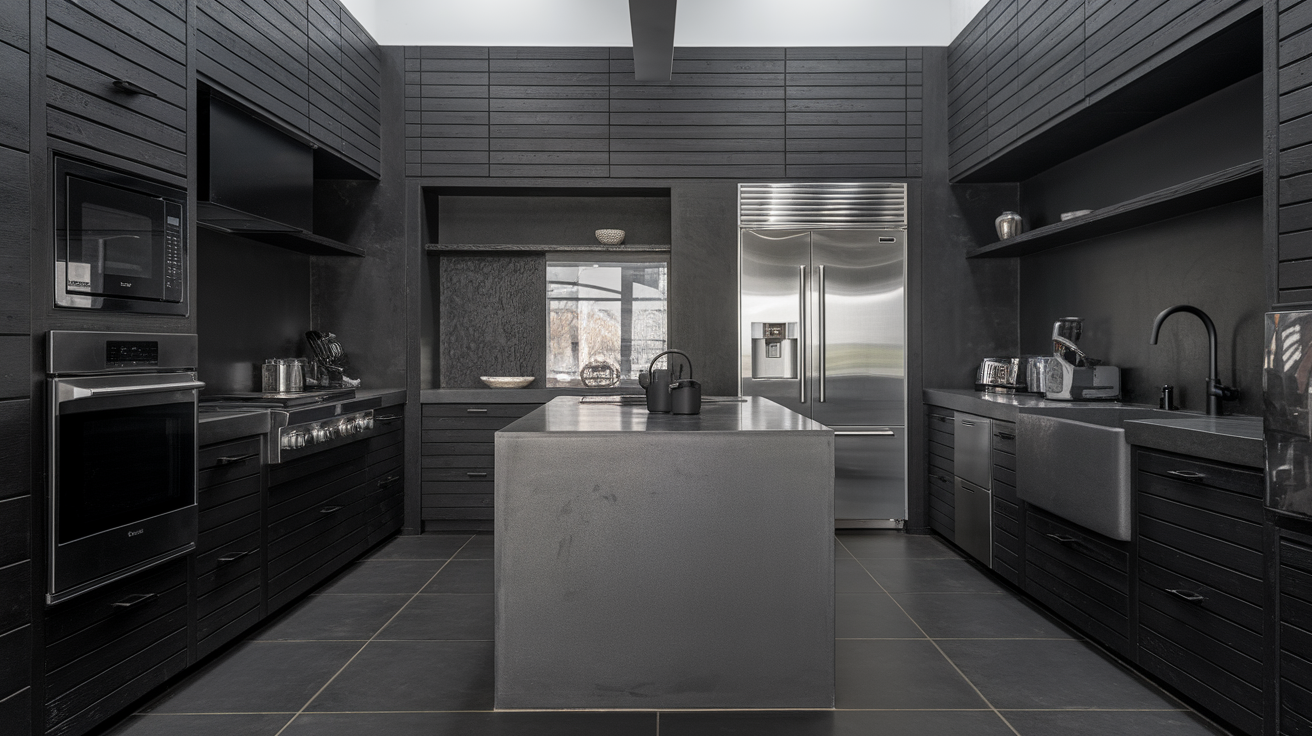
Charcoal gray islands create a sleek, tonal transition that complements dark cabinets without adding high contrast.
This sophisticated shade blends seamlessly with black, espresso, or deep navy cabinetry and complements both modern and industrial kitchen styles.
It allows textures and materials like concrete counters or brushed metals to shine. Charcoal adds refinement and cohesion, especially in open layouts where a monochromatic look supports a seamless, minimalist aesthetic.
9. Pale Blue

Pale blue brings a fresh, breezy vibe to kitchens with dark cabinetry. It introduces gentle contrast that lightens the space without dominating the design.
Often used in coastal or cottage kitchens, this soft shade pairs beautifully with white counters and silver or chrome hardware.
Pale blue islands help balance the mood, add visual lift, and offer a relaxed aesthetic that keeps the kitchen feeling open and airy.
10. Black
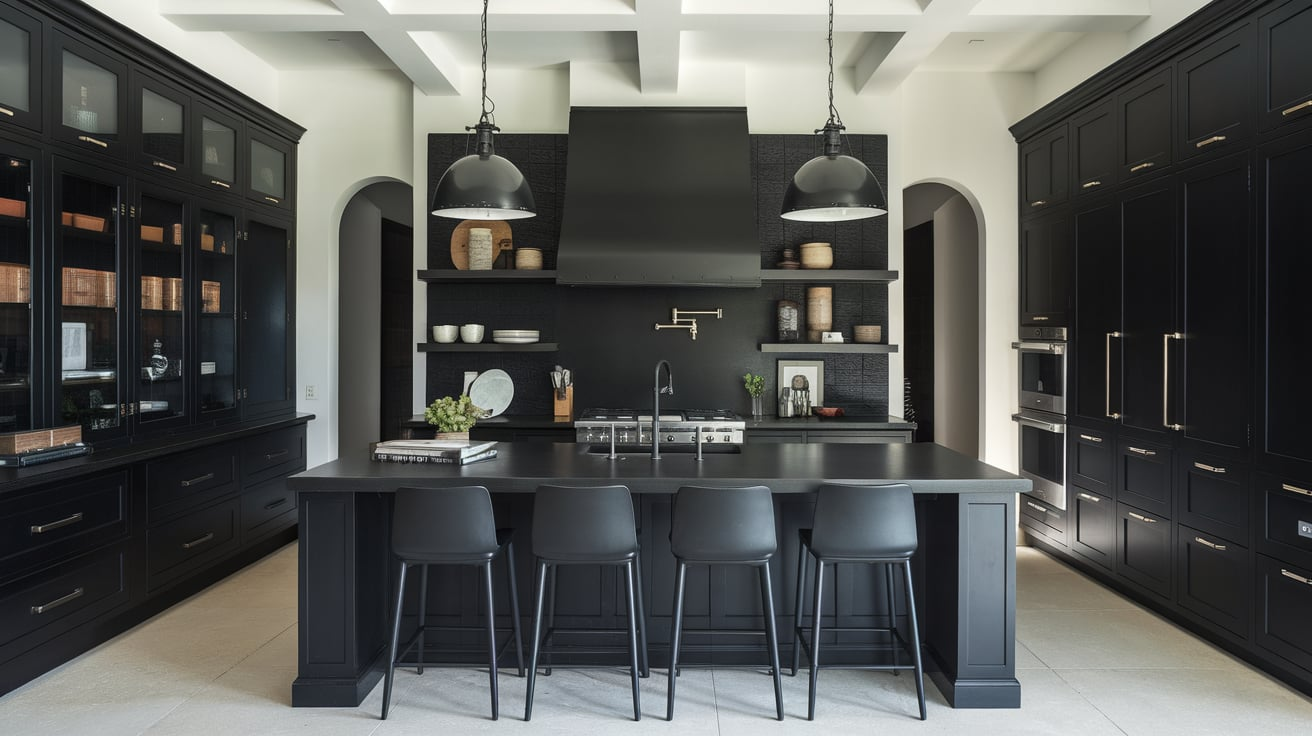
A black island paired with dark cabinets creates a bold, monochromatic look. This combination works best with texture or material contrast, such as matte black islands with glossy counters or wood accents.
It’s ideal for ultra-modern or industrial kitchens. While it may seem heavy, the use of lighting and finishes can keep the design sharp and cohesive. A black island adds drama and sophistication without stepping outside a minimalist palette.
11. Dusty Rose
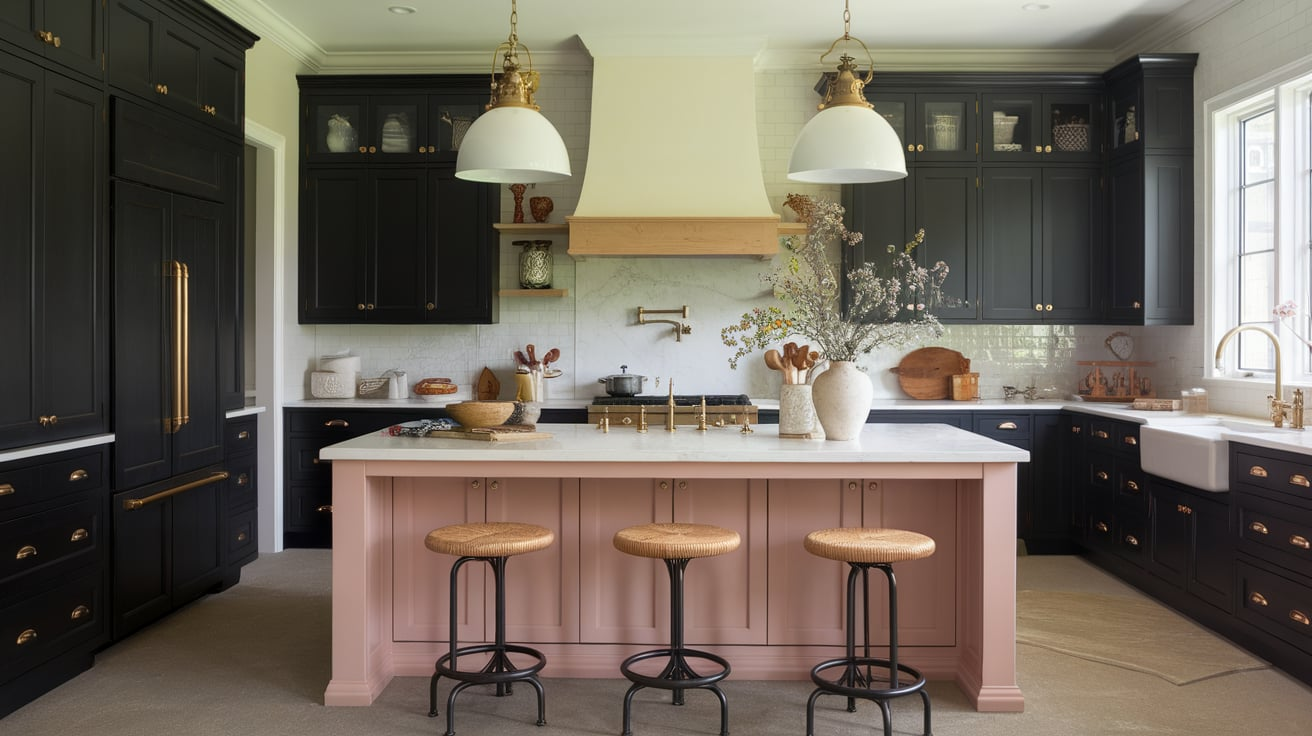
Dusty rose introduces a soft, muted pop of color that adds personality without overwhelming the space.
This blush-toned shade pairs well with eclectic, retro, or boho kitchen styles. It pairs nicely with brass or gold fixtures and light wood or white countertops.
Dusty rose offers warmth and charm while gently breaking up the darker cabinetry, creating a cozy, approachable atmosphere with a subtle, artistic twist.
12. Olive Green

Olive green islands bring a grounded, earthy tone that complements dark cabinets with rich contrast.
This muted shade fits rustic, Mediterranean, or modern farmhouse kitchens beautifully. Olive green pairs well with butcher block counters, brass hardware, and terracotta accents.
It evokes a sense of calm and connection to nature while adding depth and dimension to the overall kitchen design without straying too far from a natural palette.
13. Taupe
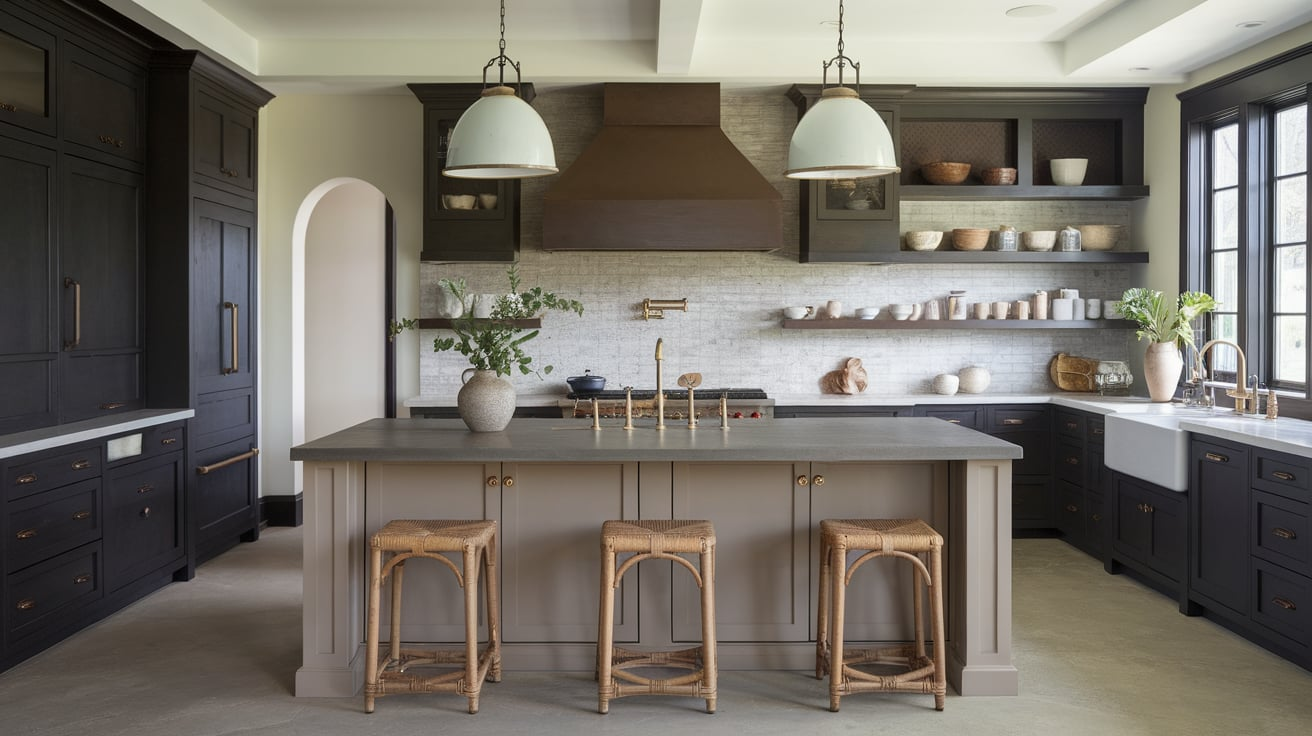
Taupe islands provide a balanced blend of gray and brown, offering a neutral yet warm complement to dark cabinets.
This adaptable shade works in traditional, transitional, or modern settings and pairs well with white stone or wood countertops.
Taupe’s subtle contrast adds sophistication and texture without making the island the focal point, allowing it to enhance the overall harmony and timeless appeal of the kitchen.
14. Teal
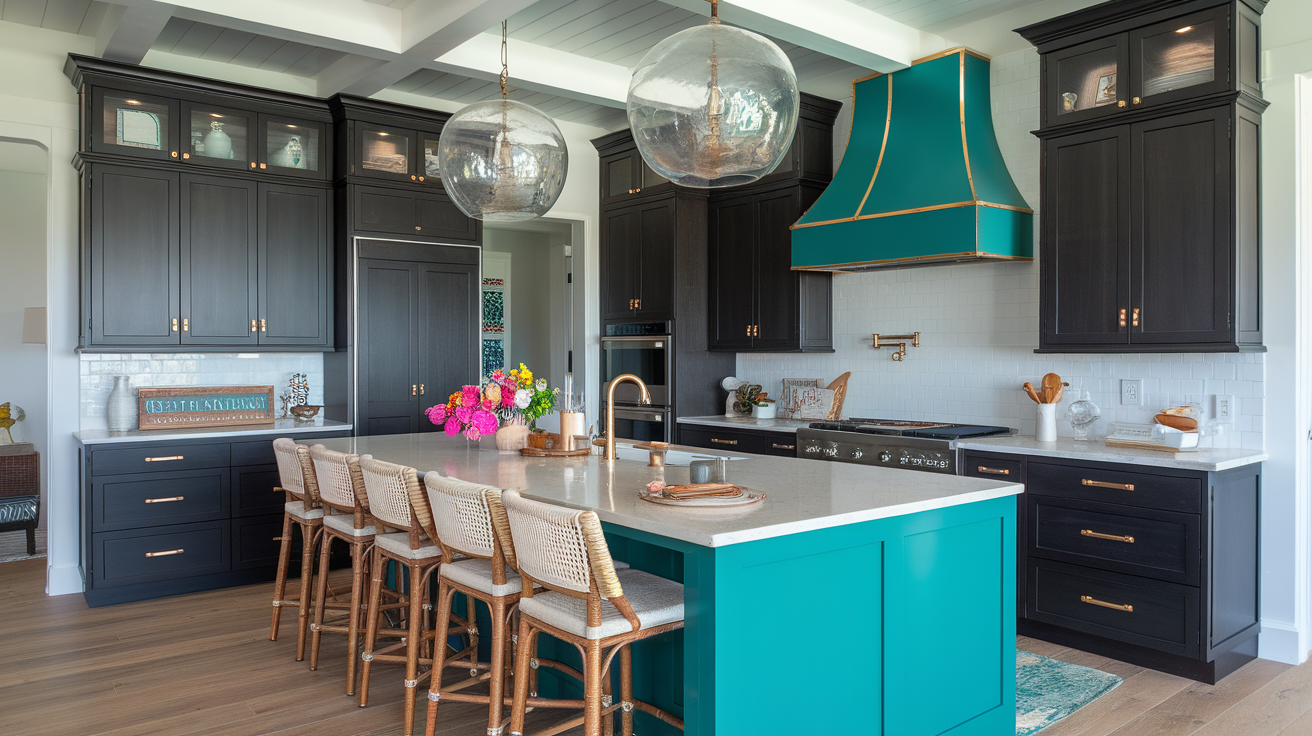
Teal brings a bold, energetic color to the kitchen island, creating a lively contrast with dark cabinetry.
This rich blue-green shade fits eclectic, coastal, or retro kitchens, especially when paired with light quartz counters and brass or gold accents.
Teal adds personality and a pop of visual interest, making it a great choice for homeowners looking to add color and flair without straying too far from a cohesive palette.
15. Mustard Yellow

Mustard yellow islands make a bold design statement and infuse kitchens with warmth and cheer. This rich, golden hue stands out against dark cabinets and suits vintage, bohemian, or industrial themes.
When paired with black hardware and reclaimed wood elements, mustard yellow creates an inviting, artistic space. It works best as a focal point, adding energy and personality while still harmonizing with deeper surrounding tones.
16. Soft Blush

Soft blush islands offer a gentle infusion of color that contrasts beautifully with dark cabinetry.
This pale pink shade brings lightness and warmth to the space, making it feel welcoming and unique. It suits romantic, modern, or vintage kitchens and pairs nicely with rose gold, copper, or matte black fixtures.
Soft blush adds a delicate yet fresh touch, ideal for those seeking subtle elegance and a non-traditional color option.
17. Forest Green
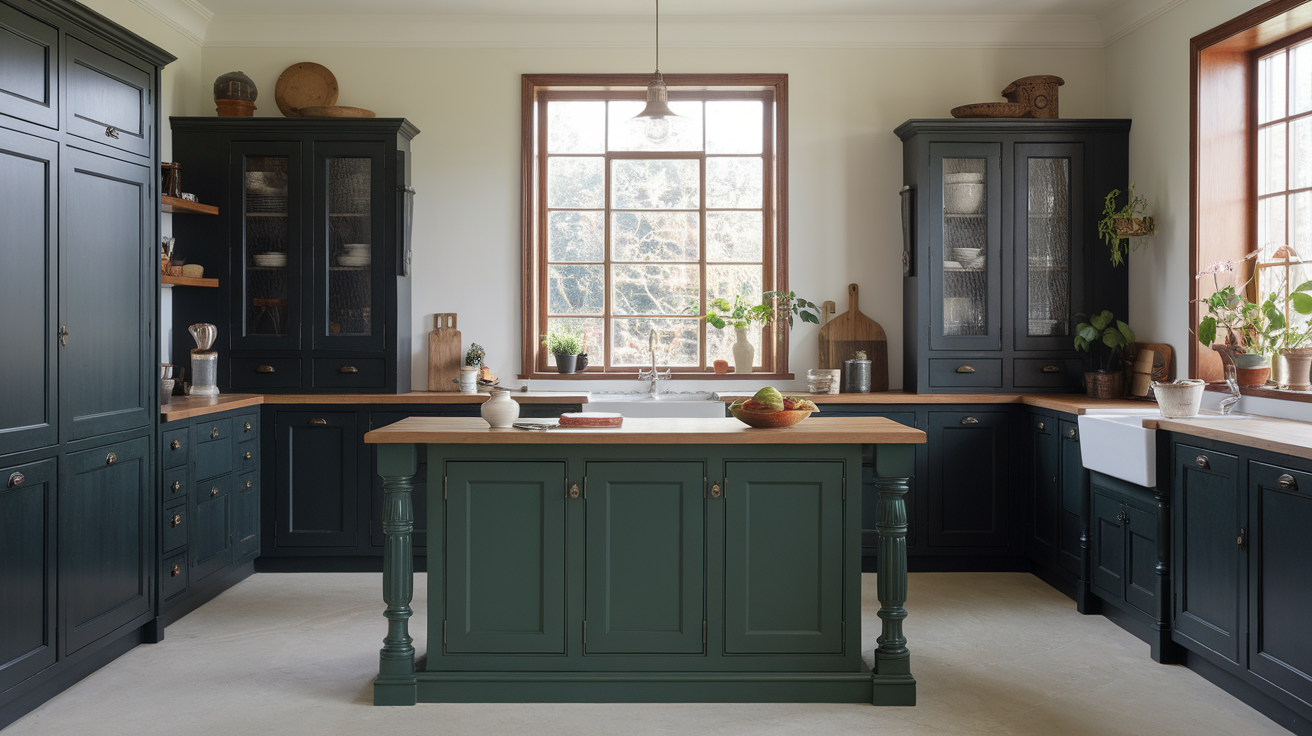
Forest green islands introduce a rich, earthy tone that complements dark cabinets while adding visual depth.
This color works well in farmhouse, classic, or transitional kitchens and blends beautifully with wood, stone, or metallic accents.
Forest green evokes nature and heritage style, making the space feel grounded and luxurious. When paired with lighter counters and warm lighting, it offers a bold yet balanced island color solution.
How to Choose the Right Finish and Countertop
The finish and countertop of your kitchen island play a key role in how the entire kitchen comes together.
A matte finish offers a soft, modern look and works well to tone down bold cabinet colors.
Glossy finishes reflect more light and add brightness to darker kitchens, while textured finishes like brushed wood or distressed paint add depth and interest.
When selecting a countertop, think about how it connects your island and cabinets.
A countertop that picks up tones from both can help the space feel balanced. For contrast, choose a surface that stands out while still complementing the color scheme.
Neutral materials like marble, granite, or quartz keep the look cohesive and timeless, while wood or darker stone surfaces can add warmth and character. Undertones should match for the best overall effect.
Conclusion
Choosing the right kitchen island color when you have dark cabinets isn’t just a design choice; it’s about setting the tone for your whole kitchen.
I’ve been through the trial and error, and I know how a thoughtful color contrast can transform the space.
Whether you lean toward light neutrals, rich jewel tones, or warm woods, your island can become the highlight that ties everything together.
So don’t overthink it, play with samples, trust your instincts, and have fun with it. Your kitchen is where life happens, and it should reflect your personality and style.
If this guide has helped spark ideas, feel free to bookmark it for your remodeling plans.
When you’re ready, take that first step. Pick up the brush, test that color, and bring your vision to life!

